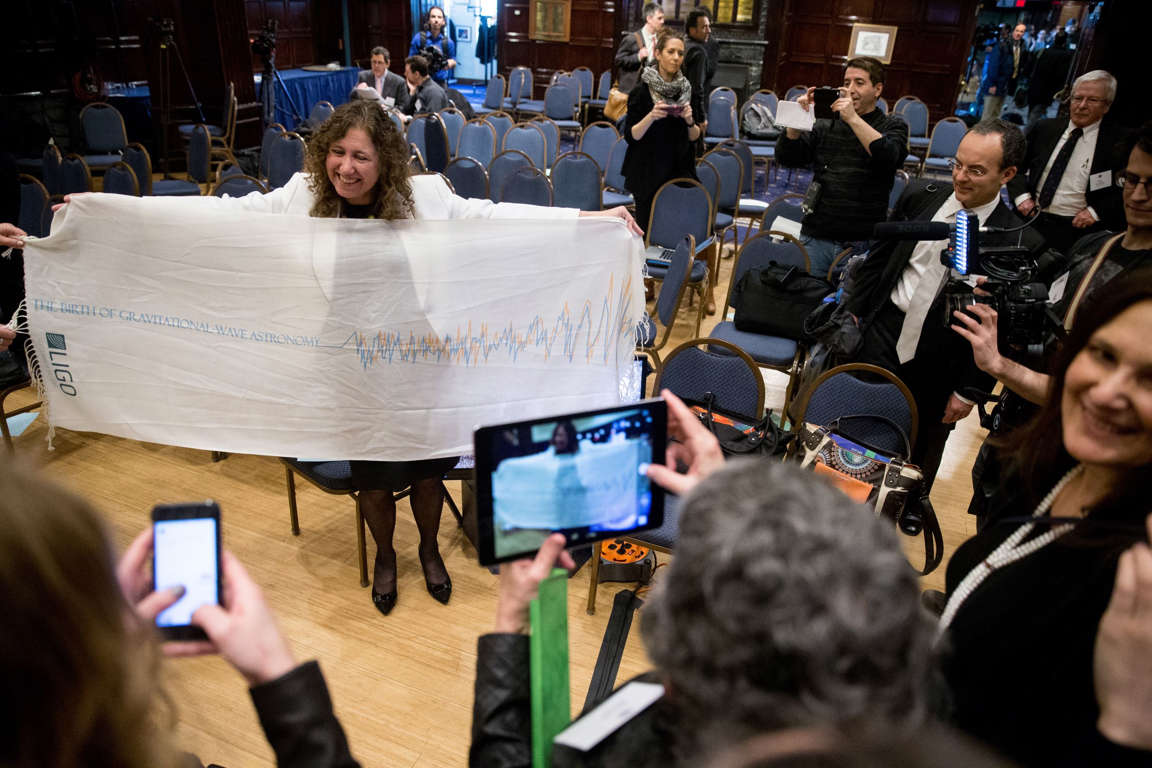Opmmur
Time Travel Professor
- Messages
- 5,049
Gravitational waves have been found, scientists say

By Todd Leopold, CNN

Now Playing Gravitational waves: The...
(24 Videos)
Life on Mars: Depends on what you see in this picture
Reitze said one black hole had the mass of 29 suns; the other was the equivalent of 36 suns. Each was perhaps 150 kilometers (90 miles) in diameter, he said.
Read More
Gravitational waves 'like Jell-O'
The two collided at half the speed of light. The event occurred approximately 1.3 billion years ago. Gravitational waves pass through everything, so the result traveled through the universe for that time before reaching Earth.
The gravitational waves stretched and compressed space around Earth "like Jell-O."
However, the waves are so small they need a detector like LIGO, capable of measuring distortions one-thousandth the size of a proton, to observe them. They were observed on September 14, 2015.
Scientists heard the sound of the black holes colliding as a "chirp" lasting one-fifth of a second.
Einstein would be surprised
Gravitational waves were predicted by Einstein in his general theory of relativity in 1915. However, in order for us to detect them, they needed to be created by a mammoth event -- like, for example, the collision of two black holes.
Black holes, gravitational areas so massive that nothing -- not even light -- can escape, are a holy grail of the gravitational wave concept. To date, we'd been able only to see their aftereffects -- black holes themselves were a conjecture. Discovery of gravitational waves confirms their existence.
Ironically, Einstein didn't think gravitational waves would ever be discovered.
"He thought gravitational waves are a beautiful construct, but they are so small nobody would ever be able to actually measure it," said Szabolcs Marka, a physics professor at Columbia University.
'A window on the universe'
LIGO is described in a statement as "a system of two identical detectors" -- one located in Livingston, Louisiana, the other in Hanford, Washington -- "carefully constructed to detect incredibly tiny vibrations from passing gravitational waves." The project was created by scientists from Caltech and MIT and funded by the National Science Foundation.
"What's really exciting is what comes next," said Reitze. "I think we're opening a window on the universe -- a window of gravitational wave astronomy."
Marka told CNN that "we will be able to study not just Einstein's general relativity -- we'll be able to find objects we only imagined would exist. We should see a universe that has never been observed before."
Marka said to think of LIGO as a "cosmic microphone," an incredibly precise listening device that can detect distortions in space-time, the fabric of the universe. It's so precise it can detect changes the size of a soccer ball in the entire Milky Way galaxy.
'The secret life of black holes'
The discovery of gravitational waves is like opening another of our senses, Marka told CNN's Rachel Crane: hearing the universe as well as seeing it.
"And when we hear the universe, we will learn about the secret life of black holes -- their birth, their death, their marriage, their feeding. We will hear when a black hole eats a neutron star," Marka said. "Nobody has 'seen' that before. We will not only understand it, we will 'see' it. It's the most fascinating thing I can imagine."
Indeed, black holes are a holy grail of the gravitational wave concept. To date, we've been able only to see their aftereffects -- black holes themselves remain a conjecture. Discovery of gravitational waves would confirm their existence.
"It's the first time the universe has spoken to us through gravitational waves," said Reitze. "Up to now we've been deaf to them."

By Todd Leopold, CNN

Now Playing Gravitational waves: The...
(24 Videos)
Life on Mars: Depends on what you see in this picture
Reitze said one black hole had the mass of 29 suns; the other was the equivalent of 36 suns. Each was perhaps 150 kilometers (90 miles) in diameter, he said.
Read More
Gravitational waves 'like Jell-O'
The two collided at half the speed of light. The event occurred approximately 1.3 billion years ago. Gravitational waves pass through everything, so the result traveled through the universe for that time before reaching Earth.
The gravitational waves stretched and compressed space around Earth "like Jell-O."
However, the waves are so small they need a detector like LIGO, capable of measuring distortions one-thousandth the size of a proton, to observe them. They were observed on September 14, 2015.
Scientists heard the sound of the black holes colliding as a "chirp" lasting one-fifth of a second.
Einstein would be surprised
Gravitational waves were predicted by Einstein in his general theory of relativity in 1915. However, in order for us to detect them, they needed to be created by a mammoth event -- like, for example, the collision of two black holes.
Black holes, gravitational areas so massive that nothing -- not even light -- can escape, are a holy grail of the gravitational wave concept. To date, we'd been able only to see their aftereffects -- black holes themselves were a conjecture. Discovery of gravitational waves confirms their existence.
Ironically, Einstein didn't think gravitational waves would ever be discovered.
"He thought gravitational waves are a beautiful construct, but they are so small nobody would ever be able to actually measure it," said Szabolcs Marka, a physics professor at Columbia University.
'A window on the universe'
LIGO is described in a statement as "a system of two identical detectors" -- one located in Livingston, Louisiana, the other in Hanford, Washington -- "carefully constructed to detect incredibly tiny vibrations from passing gravitational waves." The project was created by scientists from Caltech and MIT and funded by the National Science Foundation.
"What's really exciting is what comes next," said Reitze. "I think we're opening a window on the universe -- a window of gravitational wave astronomy."
Marka told CNN that "we will be able to study not just Einstein's general relativity -- we'll be able to find objects we only imagined would exist. We should see a universe that has never been observed before."
Marka said to think of LIGO as a "cosmic microphone," an incredibly precise listening device that can detect distortions in space-time, the fabric of the universe. It's so precise it can detect changes the size of a soccer ball in the entire Milky Way galaxy.
'The secret life of black holes'
The discovery of gravitational waves is like opening another of our senses, Marka told CNN's Rachel Crane: hearing the universe as well as seeing it.
"And when we hear the universe, we will learn about the secret life of black holes -- their birth, their death, their marriage, their feeding. We will hear when a black hole eats a neutron star," Marka said. "Nobody has 'seen' that before. We will not only understand it, we will 'see' it. It's the most fascinating thing I can imagine."
Indeed, black holes are a holy grail of the gravitational wave concept. To date, we've been able only to see their aftereffects -- black holes themselves remain a conjecture. Discovery of gravitational waves would confirm their existence.
"It's the first time the universe has spoken to us through gravitational waves," said Reitze. "Up to now we've been deaf to them."
Last edited:





